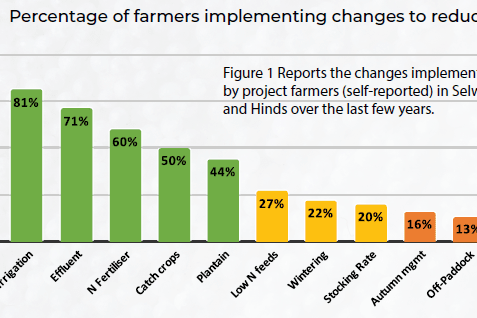Lower N future
Meeting a Sustainable Future is a levy-funded DairyNZ initiative to support farmers in the Selwyn and Hinds catchments meet their environmental obligations while optimising their farm systems for profit and resilience. By Virginia Serra.

IN 2018 THE MEETING A Sustainable Future – Hinds and Selwyn Project was launched, with the aim of working alongside a group of partner farms to identify the best options for them to achieve hefty nitrogen (N) loss reductions in a way that would not affect the profitability of their farms. Selwyn farmers have faced a 30% N loss reduction while Hinds farmers must achieve 15% by 2025, 25% by 2030 and 36% by 2035.
The project was an extension of previous N loss farm systems research, such as Pastoral 21 and Forage for Reduce N leaching.
Improved irrigation efficiency: A significant investment area for farmers. Most farms have moved to more efficient spray irrigation and are using technology to increase the accuracy of irrigation applications.
Using soil moisture as a trigger for irrigation is achieving improved water-use efficiency without compromising pasture growth. Some farmers are changing the full point trigger for irrigation during the season shoulders (when evapotranspiration rates are lower). Soil moisture can be managed slightly lower at these times to allow for as much rainfall capture as possible. This requires monitoring of soil moisture, weather forecasts and crop requirements, and adjusting irrigation targets in a soil water budget to ensure rainfall is captured and does not lead to excess nutrient loss.
Improved effluent systems and management: Significant effort and investment into improving infrastructure and management of effluent systems. Early focus on reliable infrastructure, good management practices and avoiding incidents where effluent could be at risk of entering waterways.
In recent years effluent areas have been extended to make the most of the nutrients available in effluent. Fertiliser policies have been adjusted to account for this. This has been particularly effective in reducing the amount of N fertiliser applied onfarm.
Reducing N fertiliser use. Before the N cap came into the scene in 2020, farmers in Canterbury were well underway to reduce the amount of synthetic N fertiliser used.
Farmers are now reporting the amount of N fertiliser used last season. Anecdotal information suggests that after some management adjustments, farmers have been able to operate under the N cap without a significant impact on pasture production. However, in many cases it requires some extra costs and investment.
Plantain, specifically the cultivars Tonic and Agritonic (marketed as a blend as Ecotain™) has consistently shown reduced nitrate leaching without compromising milk production or requiring significant changes to the farm system.
It is a very promising option from science, and many of the partner farms we have been working with have been incorporating plantain within their farm systems.
Catch Crops planted after an autumn or winter crop to catch the excess nitrogen in soils that otherwise may be lost to leaching has been widely implemented as well.
The reduction in nitrate leaching losses results from the crop’s rapid uptake of residual mineral nitrogen and the reduction of the soil water content of the soil, which reduces the risk of drainage.
Despite the scientific evidence of the impact of catch crops in reducing nutrient loss, some practical challenges to getting the crop on the ground on time can limit a wider implementation of this practice.
- Virginia Serra is a senior manager in DairyNZ’s solutions and development team and project manager for the “Meeting a Sustainable Future: Hinds and Selwyn” project.





